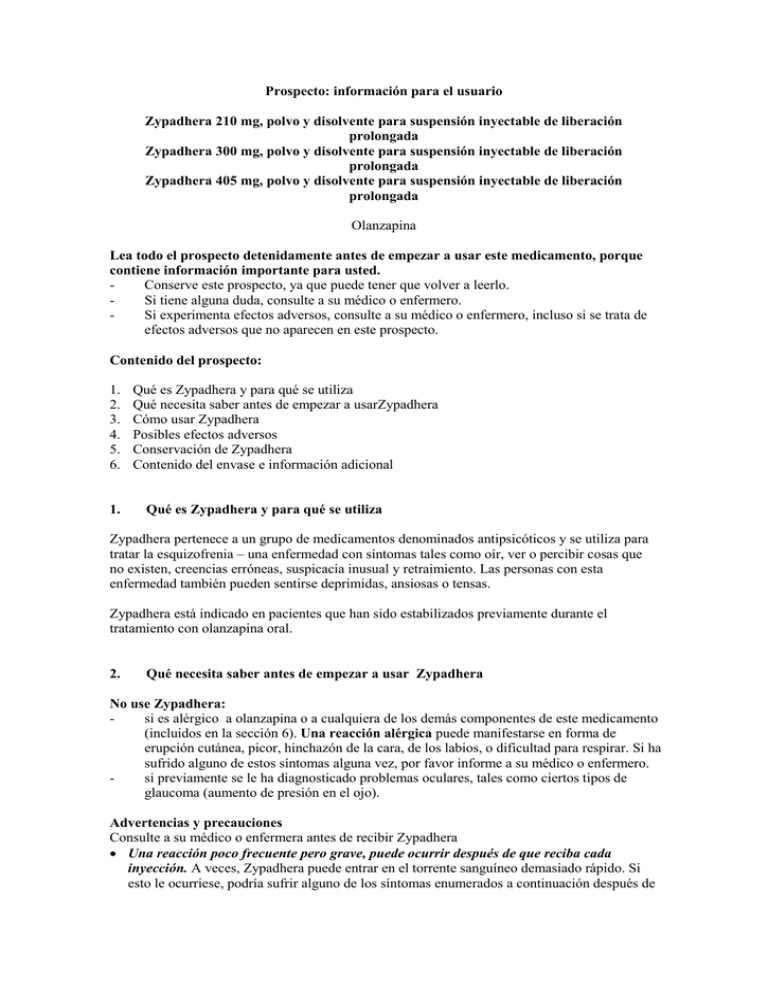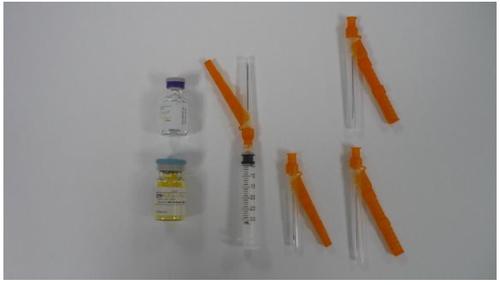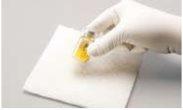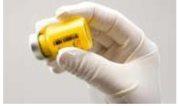

ЗИПАДХЕРА 405 мг ПОРОШОК І РОЗЧИННИК ДЛЯ ПРИГОТУВАННЯ ІН'ЄКЦІЙНОЇ СУСПЕНЗІЇ ПРОДОВЖЕНОЇ ДІЇ

Запитайте лікаря про рецепт на ЗИПАДХЕРА 405 мг ПОРОШОК І РОЗЧИННИК ДЛЯ ПРИГОТУВАННЯ ІН'ЄКЦІЙНОЇ СУСПЕНЗІЇ ПРОДОВЖЕНОЇ ДІЇ

Інструкція із застосування ЗИПАДХЕРА 405 мг ПОРОШОК І РОЗЧИННИК ДЛЯ ПРИГОТУВАННЯ ІН'ЄКЦІЙНОЇ СУСПЕНЗІЇ ПРОДОВЖЕНОЇ ДІЇ
Вступ
Опис: інформація для користувача
ZYPADHERA 210 мг порошок і розчин для ін'єкції підтримуючої дії
ZYPADHERA 300 мг порошок і розчин для ін'єкції підтримуючої дії
ZYPADHERA 405 мг порошок і розчин для ін'єкції підтримуючої дії
Оланзапін
Прочитайте уважно весь опис перед початком використання цього лікарського засобу, оскільки він містить важливу інформацію для вас.
- Збережіть цей опис, оскільки вам може знадобитися знову його прочитати.
- Якщо у вас виникли питання, проконсультуйтеся з вашим лікарем або медсестрою.
- Якщо ви відчуваєте побічні ефекти, проконсультуйтеся з вашим лікарем або медсестрою, навіть якщо це побічні ефекти, які не вказані в цьому описі. Див. розділ 4.
Зміст опису:
- Що таке ZYPADHERA і для чого вона використовується
- Що потрібно знати перед початком використання ZYPADHERA
- Як використовувати ZYPADHERA
- Можливі побічні ефекти
- Зберігання ZYPADHERA
- Зміст упаковки та додаткова інформація
1. Що таке ZYPADHERA і для чого вона використовується
ZYPADHERA містить оланзапін як активну речовину. ZYPADHERA належить до групи лікарських засобів, званих антипсихотичними, і використовується для лікування шизофренії - захворювання з симптомами, такими як чути, бачити або сприймати речі, які не існують, помилкові переконання, підозрілість та відступництво. Люди з цим захворюванням також можуть відчувати депресію, тривогу або напругу.
ZYPADHERA призначена для дорослих пацієнтів, які раніше були стабілізовані під час лікування оланзапіном всередину.
2. Що потрібно знати перед початком використання ZYPADHERA
Не використовуйте ZYPADHERA:
- якщо ви алергічні на оланзапін або будь-який інший компонент цього лікарського засобу (перелічені в розділі 6). Алергічна реакціяможе проявлятися у вигляді висипу, свербіння, набухання обличчя, губ або труднощів з диханням. Якщо ви раніше відчували будь-які з цих симптомів, повідомте про це вашому лікареві або медсестрі.
- якщо раніше у вас були діагностовані очні проблеми, такі як певні види глаукоми (збільшення тиску в оці).
Попередження та застереження
Проконсультуйтеся з вашим лікарем або медсестрою перед початком використання ZYPADHERA.
- Рідкісна, але серйозна реакція може виникнути після кожної ін'єкції.Іноді ZYPADHERA може надто швидко потрапляти в кровотік. Якщо це трапиться, ви можете відчувати будь-які з наступних симптомів після кожної ін'єкції. В деяких випадках ці симптоми можуть призвести до втрати свідомості.
• | надмірна сонливість | • | головокружіння | |
• | замішання | • | дезорієнтація | |
• | ірритабельність | • | тривога | |
• | агресивність |
| ||
• | утруднення мовлення | • | кров'яний тиск | |
• | утруднення ходьби | слабкість | ||
• | конвульсії |
|
Ці симптоми зазвичай зникають протягом 24-72 годин після ін'єкції. Після кожної ін'єкції ви повинні перебувати під спостереженням у медичному закладі протягом至少 3 годин на випадок появи будь-яких з цих симптомів.
Хоча це малоймовірно, ви можете відчувати ці симптоми після закінчення 3 годин після ін'єкції. Якщо це трапиться, негайно зверніться до вашого лікаря або медсестри. Через це ризик ви не повинні керувати транспортними засобами чи використовувати машини протягом решти дня після кожної ін'єкції.
- Якщо ви відчуваєте головокружіння або втрачаєте свідомість після ін'єкції, повідомте про це вашому лікареві або медсестрі. Ймовірно, вам потрібно буде лежати, поки ви не почувствуете себе краще. Лікар або медсестра можуть бажати виміряти ваш тиск і перевірити ваш пульс.
- Не рекомендується використання ZYPADHERA у пацієнтів похилого віку з деменцією(замішанням або втратою пам'яті), оскільки це може призвести до серйозних побічних ефектів.
- У дуже рідкісних випадках лікарські засоби цього типу можуть викликати незвичайні рухи, переважно на обличчі або язиці, або комбінацію лихоманки, прискореного дихання, потовидіння, м'язової ригідності та спання чи сонливості. Якщо це трапиться після отримання ZYPADHERA, негайно зверніться до вашого лікаря або медсестри.
- Було спостережено збільшення ваги у пацієнтів, які приймають ZYPADHERA. Ви та ваш лікар повинні регулярно перевіряти вашу вагу. Якщо це необхідно, ваш лікар може допомогти вам спланувати дієту або розглянути можливість направлення до дієтолога.
- Було спостережено підвищені рівні цукру та жирів (тригліцеридів та холестерину) у крові у пацієнтів, які приймають ZYPADHERA. Ваш лікар повинен проводити аналіз крові для контролю рівня цукру у крові та жирів перед початком використання ZYPADHERA та регулярно протягом лікування.
- Повідомте вашому лікареві, якщо ви або хтось з вашої сім'ї має історію кров'яних згортань, оскільки лікарські засоби цього типу були пов'язані з утворенням кров'яних згортань у крові.
Повідомте вашому лікареві якнайшвидше, якщо ви страждаєте на будь-які з наступних станів:
- Інсульт або "міні-інсульт" (тимчасові симптоми інсульту)
- Хвороба Паркінсона
- Проблеми з простатою
- Закупорка кишечника (паралітичний ілеус)
- Хвороба печінки чи нирок
- Захворювання крові
- Недавній інфаркт, хвороба коронарних артерій, синдром хворого синусу (аномальні серцеві ритми), нестабільна ангіна або низький кров'яний тиск.
- Цукровий діабет
- Конвульсії
- Якщо ви вважаєте, що можете мати втрату солей через тривалу діарею та блювоту або внаслідок використання діуретичних препаратів (пілок для сечовидільної системи)
Як звичайна попередність, рекомендується періодично вимірювати артеріальний тиск у пацієнтів віком понад 65 років.
Не рекомендується починати лікування ZYPADHERA, якщо вам більше 75 років.
Діти та підлітки
Пацієнти молодше 18 років не повинні використовувати ZYPADHERA.
Інші лікарські засоби та ZYPADHERA
Повідомте вашому лікареві, якщо ви приймаєте, нещодавно приймали або можете приймати будь-які інші лікарські засоби.
Особливо, повідомте вашому лікареві, якщо ви приймаєте:
- лікарські засоби для лікування хвороби Паркінсона.
- карбамазепін (антієпілептичний та стабілізуючий настрій), флювоксамін (антidepressant) або ципрофлоксацин (антібіотик) - можливо, потрібно буде змінити вашу дозу ZYPADHERA.
Якщо ви вже приймаєте антидепресанти, лікарські засоби для полегшення тривоги або для допомоги у сні (снодійні), ви можете відчувати сонливість, якщо прийматимете ZYPADHERA.
Використання ZYPADHERA з алкоголем
Ви повинні уникати будь-якого вживання алкоголю, якщо вам введено ZYPADHERA, оскільки в поєднанні з алкоголем це може викликати сонливість.
Вагітність та лактація
Якщо ви вагітні або годуєте грудьми, вважаєте, що можете бути вагітною або плануєте завагітніти, проконсультуйтеся з вашим лікарем перед прийняттям цієї ін'єкції.
Ви не повинні приймати цю ін'єкцію, якщо годуєте грудьми, оскільки невеликі кількості оланзапіну можуть потрапляти до грудного молока.
Можуть виникнути наступні симптоми у новонароджених дітей матерів, які були ліковані ZYPADHERA в останньому триместрі вагітності (останні три місяці вагітності): тремор, ригідність та/або м'язова слабкість, сонливість, агітація, проблеми з диханням та труднощі з харчуванням. Якщо ваша дитина розвиває будь-які з цих симптомів, зверніться до вашого лікаря.
Керування транспортними засобами та використання машин
Не керуйте транспортними засобами чи використовуйте машини протягом решти дня після кожної ін'єкції.
ZYPADHERA містить натрій
Одразу після відновлення цей лікарський засіб містить менше 1 ммоль натрію (23 мг) на флакон; тобто, він практично "без натрію".
3. Як використовувати ZYPADHERA
Ваш лікар визначить кількість ZYPADHERA, яку вам потрібно, та з якою частотою вам потрібно приймати ін'єкцію. ZYPADHERA вводиться в дозах 150 мг до 300 мг кожні 2 тижні або 300 мг до 405 мг кожні 4 тижні.
ZYPADHERA представлена у вигляді порошку, який ваш лікар або медсестра відновить для створення суспензії, яку потім введуть вам у м'яз стегна.
Якщо ви використовуєте більше ZYPADHERA, ніж потрібно
Цей лікарський засіб вводиться під медичним наглядом. Тому малоймовірно, що ви отримаєте надмірну кількість.
Пацієнти, які отримали більше оланзапіну, ніж потрібно, також відчували наступні симптоми:
- пришвидшений серцевий ритм, агітація/агресивність, проблеми з мовленням, незвичайні рухи (особливо на обличчі або язиці) та знижені рівні свідомості.
Інші симптоми можуть включати:
- гостру дисорієнтацію, конвульсії (епілепсія), кому, комбінацію лихоманки, прискореного дихання, потовидіння, м'язової ригідності та спання чи сонливості, повільне дихання, аспірацію, підвищений або низький кров'яний тиск, аномальні серцеві ритми.
Зверніться до вашого лікаря або лікарні негайно, якщо ви відчуваєте будь-які з цих симптомів.
Якщо ви забули використати ZYPADHERA
Не переривайте лікування лише тому, що ви починаєте відчувати себе краще. важливо, щоб ви продовжували приймати ZYPADHERA протягом всього часу, призначеного вашим лікарем.
Якщо ви пропустили прийом ін'єкції, ви повинні негайно звернутися до вашого лікаря, щоб призначити наступну ін'єкцію якнайшвидше.
Якщо у вас є будь-які інші питання щодо використання цього лікарського засобу, зверніться до вашого лікаря або медсестри.
4. Можливі побічні ефекти
Як і всі лікарські засоби, цей лікарський засіб може викликати побічні ефекти, хоча не всі люди їх відчувають.
Зверніться до вашого лікаря негайно, якщо ви маєте:
- надмірну сонливість, головокружіння, замішання, дезорієнтацію, утруднення мовлення, утруднення ходьби, м'язову ригідність або агітацію, слабкість, ірритабельність, агресивність, тривогу, підвищений кров'яний тиск або конвульсії та можете втрачати свідомість. Ці симптоми можуть бути пов'язані з тим, що іноді ZYPADHERA може надто швидко потрапляти в кровотік (частий побічний ефект, який може впливати до 1 особи з 10).
- незвичайні рухи (частий побічний ефект, який може впливати до 1 особи з 10), особливо на обличчі або язиці;
- кров'яні згортання в венах (рідкісний побічний ефект, який може впливати до 1 особи з 100), особливо в ногах (симптоми включають набухання, біль та червоність у нозі), які можуть рухатися через кров до легенів, викликаючи біль у грудній клітці та труднощі з диханням. Якщо ви відчуваєте будь-які з цих симптомів, зверніться до лікаря негайно.
- комбінацію лихоманки, прискореного дихання, потовидіння, м'язової ригідності та спання чи сонливості (частота не може бути оцінена з наявних даних)
Інші часті побічні ефекти (можуть впливати до 1 особи з 10) з ZYPADHERA включають сонливість та біль у місці ін'єкції.
Рідкісні побічні ефекти (можуть впливати до 1 особи з 1000) включають інфекцію в місці ін'єкції.
Побічні ефекти, перелічені нижче, були спостережені при прийомі оланзапіну всередину, але можуть виникнути після введення ZYPADHERA.
Інші дуже часті побічні ефекти (можуть впливати на більше 1 особи з 10) включають збільшення ваги та підвищення рівня пролактину у крові. На початку лікування деякі люди можуть відчувати головокружіння або втрачати свідомість (із сповільненим серцевим ритмом), особливо при встанні з положення лежачи або сидячого. Це відчуття зазвичай зникає самостійно, але якщо це не трапиться, зверніться до вашого лікаря.
Інші часті побічні ефекти (можуть впливати до 1 особи з 10) включають зміни рівня деяких клітин крові, жирів у кровотоці та на початку лікування тимчасові підвищення рівня печінкових ферментів; підвищення рівня цукру у крові та сечі; підвищення рівня сечовини та креатинфосфокінази у крові; підвищення апетиту; головокружіння; агітацію; тремор; незвичайні рухи (дискінезії); запор; сухість у роті; висип; втрату сили; надмірну втомлюваність; затримку рідини, що викликає набухання у руках, ногах або ногах; лихоманку; біль у суглобах; та сексуальні дисфункції, такі як зниження лібідо у чоловіків та жінок або еректильна дисфункція у чоловіків.
Інші рідкісні побічні ефекти (можуть впливати до 1 особи з 100) включають гіперчутливість (наприклад, запалення рота та горла, свербіння; висип на шкірі); цукровий діабет або погіршення діабету, пов'язані з кетоацидозом (ацетон у крові та сечі) або комою; конвульсії, переважно у пацієнтів з історією конвульсій (епілепсія); м'язову ригідність або спазми (включно з рухами очей); синдром неспокійних ніг; проблеми з мовленням; заїкання; сповільнений серцевий ритм; чутливість до сонячного світла; носові кровотечі;腹ова напруга; надмірне слиновиділення; втрату пам'яті чи забування; недержання сечі; втрату здатності сечовидільної системи; випадіння волосся; відсутність чи зниження місячних; та зміни в молочних залозах у чоловіків та жінок, такі як аномальне вироблення молока чи незвичайний ріст.
Рідкісні побічні ефекти (можуть впливати до 1 особи з 1000) включають зниження температури тіла; аномальні серцеві ритми; раптову смерть невідомої причини; запалення підшлункової залози, що викликає сильний біль у животі; лихоманку та блювоту; захворювання печінки, що проявляється у вигляді жовтого кольору шкіри та білого кольору очей; захворювання м'язів, що проявляється у вигляді болю в суглобах невідомої причини; та тривалу чи болючу ерекцію.
Дуже рідкісні побічні ефекти включають серйозні алергічні реакції, такі як реакція на лікарський засіб з еозинофілією та системними симптомами (DRESS за англійською абревіатурою). Спочатку DRESS проявляється у вигляді симптомів, подібних до грипу, з висипом на обличчі, а потім з широко поширеним висипом, лихоманкою, збільшенням лімфатичних вузлів, підвищенням рівня печінкових ферментів у аналізі крові та збільшенням кількості певного типу білих клітин крові (еозинофілів).
Під час лікування оланзапіном пацієнти похилого віку з деменцією можуть страждати на інсульт, пневмонію, недержання сечі, падіння, надмірну втомлюваність, візуальні галюцинації, підвищення температури тіла, червоність шкіри та труднощі з ходьбою. Було зареєстровано деякі випадки смерті у цій групі пацієнтів.
Оланзапін всередину може погіршувати симптоми у пацієнтів з хворобою Паркінсона.
Звіт про побічні ефекти
Якщо ви відчуваєте будь-який побічний ефект, зверніться до вашого лікаря або медсестри, навіть якщо це побічні ефекти, які не вказані в цьому описі. Ви також можете повідомити про них безпосередньо через національну систему повідомлень, включену до додатку V. Надсилаючи повідомлення про побічні ефекти, ви можете допомогти надати більше інформації про безпеку цього лікарського засобу.
5. Зберігання ZYPADHERA
Тримайте цей лікарський засіб поза зоною досяжності дітей.
Не вводьте ін'єкцію після закінчення терміну придатності, вказаного на упаковці.
Не охолоджуйте та не заморожуйте.
Було доведено хімічну та фізичну стабільність суспензії у флаконах протягом 24 годин при температурі 20-25°C. З мікробіологічної точки зору лікарський засіб повинен бути введений негайно. Якщо це не так, час зберігання та умови використання перед введенням є відповідальністю медичного працівника та зазвичай не повинні перевищувати 24 години при температурі 20-25°C. Не використовуйте цей продукт, якщо ви помітили забарвлення чи інші видимі ознаки псування.
Якщо ви не використовуєте лікарський засіб негайно, його потрібно сильно встряхнути, щоб відновити суспензію. Після видалення суспензії з флакону в шприц її потрібно використати негайно.
Лікарські засоби не повинні викидатися у водопровід чи сміття. Спитайте у вашого фармацевта, як позбутися упаковки та лікарських засобів, які вам більше не потрібні. Таким чином, ви допоможете захистити навколишнє середовище.
6. Зміст упаковки та додаткова інформація
Склад ЗИПАДЕРИ
Активний інгредієнт - оланзапін.
ЗИПАДЕРА 210 мг: кожна флакон містить моногідрат памоату оланзапіну, еквівалентний 210 мг оланзапіну.
ЗИПАДЕРА 300 мг: кожна флакон містить моногідрат памоату оланзапіну, еквівалентний 300 мг оланзапіну.
ЗИПАДЕРА 405 мг: кожна флакон містить моногідрат памоату оланзапіну, еквівалентний 405 мг оланзапіну.
Після відновлення кожний мілілітр суспензії містить 150 мг/мл оланзапіну.
Компоненти розчинника - натрію кармелоза, манітол, полісорбат 80, вода для ін'єкцій, хлоридна кислота та гідроксид натрію.
Вигляд продукту та вміст упаковки
ЗИПАДЕРА порошок для ін'єкційної суспензії з тривалою дією випускається у вигляді жовтого порошку у прозорому скляному флаконі. Ваш лікар або медсестра відновить його у суспензію, яку введуть у вигляді ін'єкції, використовуючи вміст флакону з розчинником для ЗИПАДЕРИ, який подається у вигляді прозорої, безбарвної або світло-жовтої рідини у прозорому скляному флаконі.
ЗИПАДЕРА - це порошок і розчинник для ін'єкційної суспензії з тривалою дією. Кожна упаковка містить флакон з порошком для ін'єкційної суспензії з тривалою дією, флакон з 3 мл розчинника, шприц з безпечною голкою діаметром 19 і довжиною 38 мм та три окремі безпечні голки; голку діаметром 19 і довжиною 38 мм та дві голки діаметром 19 і довжиною 50 мм.
Власник дозволу на торгівлю
CHEPLAPHARM Registration GmbH, Weilerstr. 5e, 79540 Lörrach, Німеччина.
Виробник
Lilly S.A., Avda. de la Industria 30, 28108 Alcobendas, Madrid, Іспанія.
Дата останнього перегляду цієї інструкції:
Детальна інформація про цей препарат доступна на сайті Європейського агентства з лікарських засобів http://www.ema.europa.eu/.
ІНСТРУКЦІЇ ДЛЯ МЕДИЧНИХ ПРАЦІВНИКІВ
ІНСТРУКЦІЇ ДЛЯ ВІДНОВЛЕННЯ ТА ВВЕДЕННЯ
ЗИПАДЕРА оланзапін порошок і розчинник для ін'єкційної суспензії з тривалою дією
ТІЛЬКИ ДЛЯ ГЛУБОКОЇ М'ЯСОЇ ІН'ЄКЦІЇ У ГЛУТЕВУ М'ЯСОУ.
НЕ ВВЕДЕНИ ВНУТРІШНЬОВЕННО ЧЕРЕЗ ВЕНУ АБО ПІДШКІРНО.
Відновлення
КРОК 1: Підготовка матеріалів
Упаковка включає:
- Флакон з порошком ЗИПАДЕРИ для ін'єкційної суспензії з тривалою дією
- Флакон з розчинником для ЗИПАДЕРИ
- Шприц з голкою та безпечним пристроєм (гіподермічний пристрій)
- Голка діаметром 19 і довжиною 38 мм
- Дві голки діаметром 19 і довжиною 50 мм
- Інструкція
- Картка з інструкціями для відновлення та введення (цей документ)
- Інформація про безпеку та інструкції з використання гіподермічного пристрою
|
Рекомендується використовувати рукавички, оскільки ЗИПАДЕРА може викликати подразнення шкіри.
Відновлювати порошок ЗИПАДЕРИ для ін'єкційної суспензії з тривалою дією виключно з використанням розчинника, який постачається в упаковці, за допомогою стандартних асептичних технік для відновлення парентеральних продуктів.
КРОК 2: Визначення об'єму розчинника для відновлення
Ця таблиця вказує кількість розчинника, необхідну для відновлення порошку ЗИПАДЕРИ для ін'єкційної суспензії з тривалою дією.
Концентрація флакону ЗИПАДЕРИ (мг) | Об'єм розчинника для додавання (мл) |
210 | 1,3 |
300 | 1,8 |
405 | 2,3 |
Важливо підкреслити, що флакон містить більше розчинника, ніж потрібно для відновлення продукту.
КРОК 3: Відновлення ЗИПАДЕРИ
- Потрясти флакон, щоб звільнити порошок.
- Відкрити шприц та голку, попередньо упаковану з пристроєм захисту голки. Відкрити пластиковий пакет та витягнути пристрій. З'єднати шприц (якщо він ще не з'єднаний) з конектором типу Luer пристрою одним простим поворотом. Натиснути голку на пристрій, повертаючи її за годинниковою стрілкою. Потім відразу ж витягнути захисний ковпачок голки. Якщо не слідувати цим інструкціям, може статися травма від уколу голки.
- Витягнути об'єм розчинника, визначений на етапі 2, всередину шприца.
- Ввести об'єм розчинника, необхідний для відновлення, у флакон з порошком.
- Витягнути повітря, щоб рівняти тиск у флаконі.
- Витягнути голку, тримаючи флакон догори, щоб запобігти витіканню розчинника.
- Надіти пристрій захисту голки. Помістити голку у свою оболонку, використовуючи техніку з однією рукою. Виконати цю операцію однією рукою, здійснюючи м'який тиск на оболонку проти плоскої поверхні. НАСТИСНУВШИ НА ОБОЛОНКУ (Фігура 1), ГОЛКА З'ЄДНУЄТЬСЯ З НІЮ ТВЕРДО (Фігура 2)
- Перевірити візуально, щоб голка була повністю з'єднана з захисною оболонкою. Витягнути пристрій з голкою, коли це необхідно, згідно з певною медичною процедурою. Витягнути, тримаючи конектор типу Luer пристрою захисту голки за допомогою великого та вказівного пальців, та залишаючи інші три пальці віддаленими від пристрою, де знаходиться голка (Фігура 3).
|
- Потрясти флакон сильно та багаторазово проти твердої поверхні, поки не зникне видимий порошок. Захистити поверхню, щоб заглушити удар. (Див. Фігуру А)
|
Фігура А: Потрясти сильно для змішування
- Перевірити флакон візуально, щоб визначити агрегацію порошку. Порошок, який не знаходиться у суспензії, має вигляд світло-жовтих сухих грудок, прикріплених до флакону. Можливо, потрібно буде продовжувати потрясати, якщо грудки залишаються.
|
Без суспензії: видимі грудки Підвіска: без грудок
Фігура Б: Перевірити, чи є порошок без суспензії, та продовжувати потрясати, якщо це необхідно.
- Потрясти флакон енергійно, поки суспензія не матиме однорідного вигляду з однорідним кольором та текстурами. Підвісний продукт буде виглядати жовтим та непрозорим. (Див. Фігуру В)
|
Фігура В: Потрясти флакон енергійно
Якщо утворюється піна, дайте флакону постояти, щоб піна розійшлася. Якщо продукт не використовується негайно, його потрібно потрясти енергійно, щоб досягти повторної підвіски. Відновлений ЗИПАДЕРА залишається стабільним у флаконі до максимально 24 годин.
Введення
КРОК 1: Ввести ЗИПАДЕРУ
Ця таблиця підтверджує кінцевий об'єм суспензії ЗИПАДЕРИ, який потрібно ввести. Концентрація суспензії становить 150 мг/мл оланзапіну.
Доза (мг) | Кінцевий об'єм для введення (мл) |
150 | 1,0 |
210 | 1,4 |
300 | 2,0 |
405 | 2,7 |
- Визначити, яку голку потрібно використовувати для введення препарату пацієнтові. Для пацієнтів з ожирінням рекомендується використовувати голки довжиною 50 мм:
- Якщо для введення використовується голка довжиною 50 мм, надіти голку діаметром 38 мм на шприц для витягування необхідного об'єму суспензії.
- Якщо для введення використовується голка довжиною 38 мм, надіти голку діаметром 50 мм для витягування необхідного об'єму суспензії.
- Витягнути повільно необхідну кількість.
- Надіти пристрій захисту голки та витягнути голку зі шприца.
- Надіти голку діаметром 50 мм або 38 мм на шприц перед введенням. Як тільки суспензія буде витягнута з флакону та перекинута у шприц, її потрібно ввести негайно.
- Вибрати та підготувати місце введення в області сідниць. НЕ ВВЕДЕНИ ВНУТРІШНЬОВЕННО ЧЕРЕЗ ВЕНУ АБО ПІДШКІРНО.
- Після введення голки аспірувати кілька секунд, щоб підтвердити, що не виходить крові. Якщо кров аспірується всередину шприца, викинути шприц та підготувати нову суспензію. Введення повинно здійснюватися з твердо та безперервно.
НЕ МАСАЖУВАТИ МІСЦЕ ВВЕДЕННЯ.
- Надіти пристрій захисту голки. (Фігура 1 та 2)
- Викинути флакони, шприц, використані голки, додаткову голку та залишковий розчинник згідно з клінічними процедурами. Флакон призначений для одноразового використання.
- Країна реєстрації
- Діючі речовини
- Потрібен рецептТак
- Виробник
- Інформація є довідковою і не є медичною порадою. Перед прийомом будь-яких препаратів обов'язково проконсультуйтеся з лікарем. Oladoctor не несе відповідальності за медичні рішення, прийняті на основі цього контенту.
- Альтернативи до ЗИПАДХЕРА 405 мг ПОРОШОК І РОЗЧИННИК ДЛЯ ПРИГОТУВАННЯ ІН'ЄКЦІЙНОЇ СУСПЕНЗІЇ ПРОДОВЖЕНОЇ ДІЇФорма випуску: ТАБЛЕТКА, 10 мгДіючі речовини: olanzapineВиробник: Neuraxpharm Spain S.L.Потрібен рецептФорма випуску: ТАБЛЕТКА, 2,5 мгДіючі речовини: olanzapineВиробник: Neuraxpharm Spain S.L.Потрібен рецептФорма випуску: ТАБЛЕТКА, 5 мгДіючі речовини: olanzapineВиробник: Neuraxpharm Spain S.L.Потрібен рецепт
Аналоги ЗИПАДХЕРА 405 мг ПОРОШОК І РОЗЧИННИК ДЛЯ ПРИГОТУВАННЯ ІН'ЄКЦІЙНОЇ СУСПЕНЗІЇ ПРОДОВЖЕНОЇ ДІЇ в інших країнах
Найкращі аналоги з тією самою діючою речовиною та терапевтичним ефектом.
Аналог ЗИПАДХЕРА 405 мг ПОРОШОК І РОЗЧИННИК ДЛЯ ПРИГОТУВАННЯ ІН'ЄКЦІЙНОЇ СУСПЕНЗІЇ ПРОДОВЖЕНОЇ ДІЇ у Польща
Аналог ЗИПАДХЕРА 405 мг ПОРОШОК І РОЗЧИННИК ДЛЯ ПРИГОТУВАННЯ ІН'ЄКЦІЙНОЇ СУСПЕНЗІЇ ПРОДОВЖЕНОЇ ДІЇ у Україна
Лікарі онлайн щодо ЗИПАДХЕРА 405 мг ПОРОШОК І РОЗЧИННИК ДЛЯ ПРИГОТУВАННЯ ІН'ЄКЦІЙНОЇ СУСПЕНЗІЇ ПРОДОВЖЕНОЇ ДІЇ
Консультація щодо дозування, побічних ефектів, взаємодій, протипоказань та поновлення рецепта на ЗИПАДХЕРА 405 мг ПОРОШОК І РОЗЧИННИК ДЛЯ ПРИГОТУВАННЯ ІН'ЄКЦІЙНОЇ СУСПЕНЗІЇ ПРОДОВЖЕНОЇ ДІЇ – за рішенням лікаря та згідно з місцевими правилами.















